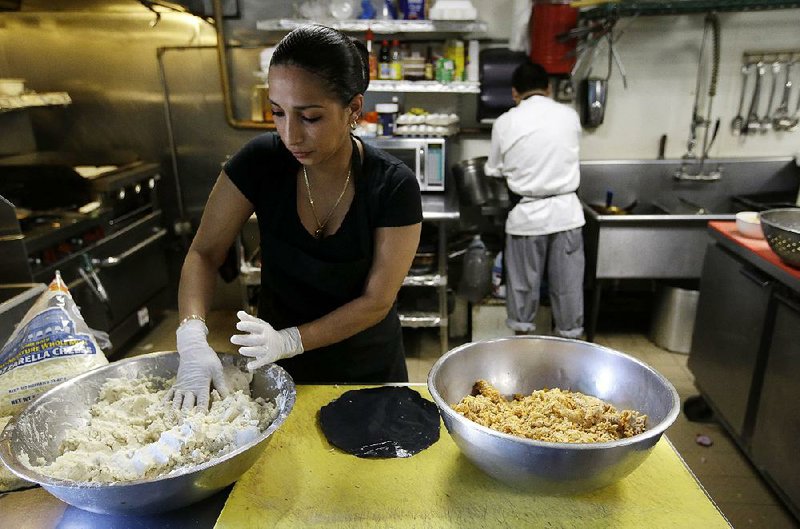CHELSEA, Mass. -- Guatemalan bakeries, Honduran restaurants and Salvadoran markets are joining an already ethnically diverse mix of businesses in downtown Chelsea, an industrial city across the Mystic River from Boston.
Among them is Catracho's, a modest Honduran eatery recently purchased by Johanna Mateo, who was born in New York and raised in Honduras until she was 12, when she joined her older sister in Chelsea.
"I always wanted to reinvest in Chelsea," said Mateo, 27, who plans to expand to a vacant storefront next door. "I like the roots it's set within the Latin American community, and I want to keep it that way."
With a population of about 40,000 people, Chelsea is a microcosm of broader changes sweeping the United States, as the number of Central American migrants increases and the number of Mexican migrants decreases. Mexico generated one of the largest immigration waves in U.S. history, starting in 1965 and lasting well into this century until an improved Mexican economy and lower birthrates helped reverse the trend.
Now, more migrants are fleeing poverty and violence in Central America's Northern Triangle.
Mexicans are still the largest group in the U.S. illegally but are down to 5 million in 2017 from 7 million a decade earlier, while Central Americans rose by 400,000 to 1.9 million and Asians also grew, the Pew Research Center reported last month. Nationwide, Pew estimated 10.5 million people in the U.S. illegally, down from a peak of 12.2 million a decade earlier.
The dynamic is playing out at the state level, said Jeffrey Passel, co-author of the report. Only five states saw statistically significant increases from 2007 to 2017, led by Massachusetts and followed by Maryland. Both are magnets for Central Americans.
California, with its large numbers of Mexicans, and other migrant-heavy states such as Florida, Illinois, New Jersey and New York have fewer people in the country illegally.
The changes extend to migrants regardless of legal status.
In Massachusetts, 8% of migrants are Central Americans, while less than 1% are Mexican, according to census data analyzed by the Migration Policy Institute. In Maryland, 24% of migrants are Central American, compared with only 4% Mexican. Nationwide, 33% of migrants are Central American and 25% are Mexican.
The demographic shifts are transforming the Boston area and helping fuel its economic boom, said Luc Schuster, director of the Boston Indicators project.
Boston's urban ring cities have seen the most marked changes. Just two decades ago, Chelsea and its neighbors -- Everett, Malden, Revere and Lynn -- were all majority white. Now, they're among the region's most diverse communities, Schuster's study found.
Chelsea is now more than 60% Hispanic. More than one-third of residents hail from Central America, mostly from El Salvador, Honduras and Guatemala.
Gladys Vega, the longtime head of the Chelsea Collaborative, a community advocacy group, says Hispanic immigration helped Chelsea recover from its low point in the 1990s when it faced insolvency.
"Latino immigrants helped rebuild Chelsea when people didn't believe in Chelsea," Vega said. "They invested in little storefronts that have grown and become established. They bought homes and they took pride in them. The contributions of the community are all around."
The transition hasn't been without challenges.
Many of the new high school-age students from Central America are coming from rural areas where they might not have attended school beyond the fourth grade, meaning the district needs more teachers, tutors and social workers, said Superintendent Mary Bourque. The district of roughly 6,300 students is 86% Hispanic, with about 40% considered English-language learners.
"We've absolutely struggled," Bourque said. "But if we were appropriately funded in the state budget, addressing their needs would be far easier."
Local nonprofits and police, meanwhile, have taken new approaches to adjust to the changed community.
Roca, an organization that helps young adults with criminal records get jobs, launched an initiative three years ago focused on making sure Central American youths stay in school and away from gangs. Two years ago, Chelsea police were involved in a major takedown of some 60 MS-13 members by federal and local authorities that helped stem a rash of violence that included nine homicides.
Last summer, Chelsea Police Chief Brian Kyes joined Boston's police commissioner and others on a trip to El Salvador to build ties with Salvadoran law enforcement and understand how the gang communicates and recruits for its U.S. affiliates.
At the same time, Kyes stresses that his officers -- nearly 40% of whom are fluent in Spanish -- respect Chelsea's long-standing sanctuary city policy, which prohibits the department from getting involved in immigration enforcement actions that don't concern public safety.
"We're one big community, regardless of where we or our parents came from," he said.
Information for this article was contributed by Elliot Spagat of The Associated Press.
A Section on 07/08/2019

